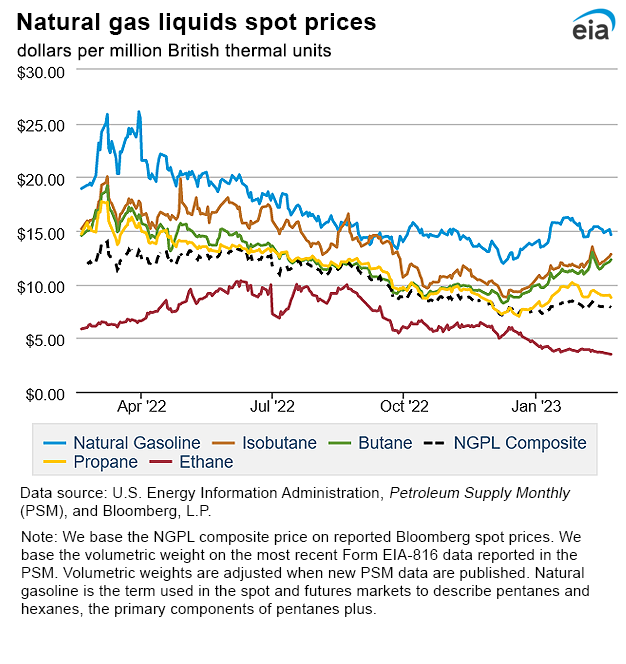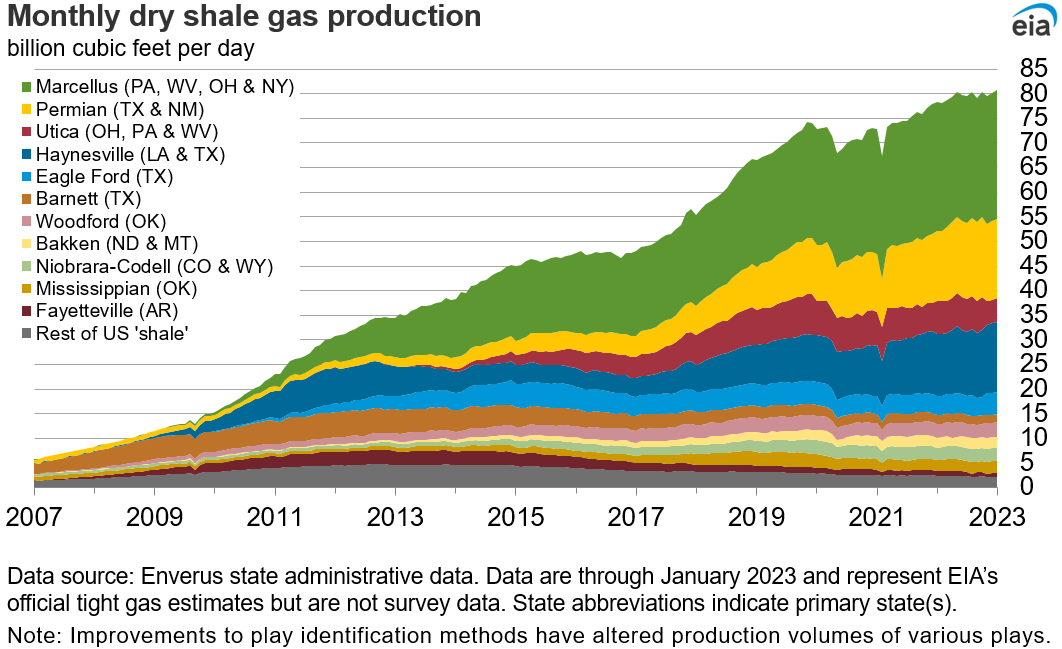In the News:
Natural gas pipeline capacity additions between states are the lowest since 1995
In 2022, 897 million cubic feet per day (MMcf/d) of interstate natural gas pipeline capacity was added collectively from five projects, according to our latest State-to-State Capacity Tracker, which contains information on the capacity of natural gas pipelines that cross state and international borders. The interstate natural gas pipeline capacity added in 2022 is the lowest since 1995, the earliest year for which data are available.
Interstate capacity additions were low in 2022 because of a greater focus on intrastate capacity (which does not cross state borders and so are not captured in our State-to-State Capacity Tracker) and lower overall capital expenditures by oil and natural gas companies. Projects that reconfigure pipeline flows to accommodate growing Appalachian natural gas production, which drove interstate pipeline capacity additions for many years, are mostly completed. Most of the natural gas production growth since about 2017 has come from the Permian and Haynesville regions. These two regions are located very close to liquefied natural gas (LNG) export terminals along the Gulf Coast. In Texas and Louisiana, intrastate projects have increased takeaway capacity and connected natural gas production to LNG export terminals instead of longer interstate pipeline projects that cross state lines.
Building large-scale, commercial natural gas pipelines that cross state boundaries involves a number of contractual, engineering, regulatory, and financial requirements. These requirements may involve more coordination and can take longer to complete compared with intrastate pipeline projects.
In 2022, five projects increased interstate capacity. The projects focused primarily on upgrading compressor stations, with only one project building a relatively small amount of new pipe:
- Columbia Gulf Transmission’s Louisiana XPress Project increased capacity from Mississippi to Louisiana by 493 MMcf/d and from Tennessee to Mississippi by 50 MMcf/d. This project added three compressor stations and upgraded an additional compressor station to increase the ability to deliver natural gas from the Appalachia Basin to Louisiana.
- Florida Gas Transmission’s Mobile County Project increased capacity from Mississippi to Alabama by 175 MMcf/d. This project modified the CS10 compressor station in Perry County, Mississippi, to add additional west-to-east capacity to help meet demand in Mobile County, Alabama.
- Florida Gas Transmission’s Southwest Alabama Project increased capacity from Mississippi to Alabama by 100 MMcf/d. This project upgraded a compressor station to increase capacity delivered to Escambia County, Alabama.
- ANR Pipeline Company’s Wisconsin Access Project increased capacity from Illinois to Wisconsin by 51 MMcf/d by upgrading several meter and filtering stations on the ANR Pipeline. The project helped alleviate constraints in parts of northern and central Wisconsin resulting from growth in residential and commercial communities in those areas.
- Gulfstream Natural Gas’s Gulfstream Phase VI Expansion Project increased capacity by 28 MMcf/d between Alabama and Florida by installing about four miles of pipe and a booster compressor station. This project helped increase natural gas flows to Tampa Electric Company’s Big Bend Power Plant.
Market Highlights:
(For the week ending Wednesday, February 22, 2023)Prices
- Henry Hub spot price: The Henry Hub spot price fell 36 cents from $2.44 per million British thermal units (MMBtu) last Wednesday to $2.08/MMBtu yesterday.
- Henry Hub futures prices: The price of the March 2023 NYMEX contract decreased 29.7 cents, from $2.471/MMBtu last Wednesday to $2.174/MMBtu yesterday. The price of the 12-month strip averaging March 2023 through February 2024 futures contracts declined 22.5 cents to $3.003/MMBtu.
- Select regional spot prices: Week-over-week changes in natural gas spot prices were mixed this report week (Wednesday, February 15, to Wednesday, February 22), generally rising in the West and Northeast and falling in the Midcontinent and South. Week-over-week price changes at major pricing hubs ranged from an increase of $2.25/MMBtu at Algonquin Citygate to a decrease of $0.79/MMBtu at the Waha hub.
- In the Northeast, most prices increased week over week, as cooler weather moved back into the region. At the Algonquin Citygate, which serves Boston-area consumers, the price increased $2.25/MMBtu from $2.13/MMBtu last Wednesday to $4.38/MMBtu yesterday, and the largest price change occurred yesterday when the price increased $1.95 from $2.43/MMBtu to $4.38/MMBtu. Temperatures in the Boston Area averaged 43°F this report week, 10°F above normal, but dropped at the end of the report week. On Monday, temperatures in the Boston Area averaged 53°F, while yesterday they averaged 39°F. Farther south, at the Transcontinental Pipeline Zone 6 trading point for New York City, the price decreased 7 cents from $2.05/MMBtu last Wednesday to $1.98/MMBtu yesterday. In the New York-Central Park Area, temperatures for the week averaged 47°F, 10°F above normal, leading to 72 fewer heating degree days (HDDs) than normal. Total consumption of natural gas increased 3%, or 0.6 billion cubic feet per day (Bcf/d), week over week in the Northeast, according to data from S&P Global Commodity Insights.
- Spot natural gas prices across the West were up since last Friday and increased markedly yesterday as a cold front swept into the region. The price at Sumas on the Canada-Washington border rose $2.00 from $6.36/MMBtu last Wednesday to $8.36/MMBtu yesterday. On Monday, temperatures in the Seattle City Area averaged 46°F, while yesterday they averaged 34°F, which is 10°F below normal. The price at PG&E Citygate in Northern California rose 73 cents, up from $7.44/MMBtu last Wednesday to $8.17/MMBtu yesterday. The price at SoCal Citygate in Southern California increased 70 cents from $7.68/MMBtu last Wednesday to $8.38/MMBtu yesterday. Total natural gas consumption in the West fell 2% (0.3 Bcf/d) week over week, but it rose 41% from Monday through Wednesday. On Tuesday, February 14, Southern California Gas (SoCalGas) issued a notice of reduced operating capacity by 800 million cubic feet per day (MMcf/d) in the North Needles subzone and by 280 MMcf/d in the North Desert Zone until further notice. To a large degree, these reductions in operating capacity offset the improved deliverability on El Paso’s Line 2000, which returned to full service on February 15.
- Along the Gulf Coast of South Texas and across the Southeast, prices fell this report week. The Florida Gas Transmission (FGT) Citygate price fell 29 cents from $2.56/MMBtu last Wednesday to $2.27/MMBtu yesterday. The price at the Waha Hub in West Texas, which is located near Permian Basin production activities, was the lowest price yesterday among major price hubs at $1.32/MMBtu, down 79 cents this report week. The Waha Hub traded 76 cents below the Henry Hub price yesterday, compared with last Wednesday when it traded 33 cents below the Henry Hub price. Temperatures in the Houston Area averaged 61°F this report week, 3°F above normal. Yesterday, temperatures in the Houston Area averaged 76°F, 16°F above normal. Total consumption of natural gas in South Texas and across the Southeast combined decreased 1% (0.2 Bcf/d) week over week, according to data from S&P Global Commodity Insights.
- International futures prices: International natural gas futures prices decreased this report week to their lowest levels since the third quarter of 2021. According to Bloomberg Finance, L.P., weekly average front-month futures prices for liquefied natural gas (LNG) cargoes in East Asia decreased $2.57 to a weekly average of $15.34/MMBtu. Natural gas futures for delivery at the Title Transfer Facility (TTF) in the Netherlands decreased $1.04 to a weekly average of $15.64/MMBtu. In the same week last year (week ending February 23, 2022), the prices in East Asia and at TTF were $25.81/MMBtu and $26.36/MMBtu, respectively.
- Natural gas plant liquids (NGPL) prices: The natural gas plant liquids composite price at Mont Belvieu, Texas, fell by 20 cents/MMBtu, averaging $7.90/MMBtu for the week ending February 22. Ethane prices fell 4%, while natural gas prices at the Houston Ship Channel fell 12% week over week, widening the ethane premium to natural gas by 4%. Ethylene spot prices rose 1%, widening the ethylene to ethane premium by 4%. Both Brent crude oil and propane prices fell by 3%, resulting in a 4% decrease in the propane discount relative to crude oil. The normal butane price remained relatively unchanged, while the price of isobutane fell 1% and the natural gasoline price fell 2%.
Daily spot prices by region are available on the EIA website.
Supply and Demand
- Supply: According to data from S&P Global Commodity Insights, the average total supply of natural gas was relatively flat, rising by 0.2% (0.2 Bcf/d) compared with the previous report week. Dry natural gas production decreased by 0.2% (0.2 Bcf/d), and this decline was offset by an increase in average net imports from Canada, up by 7.6% (0.3 Bcf/d) from last week.
- Demand: Total U.S. consumption of natural gas rose by 2.3% (2.0 Bcf/d) compared with the previous report week, according to data from S&P Global Commodity Insights. Natural gas consumed for power generation climbed by 1.5% (0.5 Bcf/d) week over week. Industrial sector consumption increased by 0.5% (0.1 Bcf/d), and in the residential and commercial sectors, consumption increased by 4.3% (1.4 Bcf/d). Natural gas exports to Mexico increased 10.7% (0.6 Bcf/d). Natural gas deliveries to U.S. LNG export facilities (LNG pipeline receipts) averaged 13.1 Bcf/d, or 0.1 Bcf/d higher than last week.
Liquefied Natural Gas (LNG)
- Pipeline receipts: Overall weekly average natural gas deliveries to U.S. LNG export terminals increased by 1.0% (0.1 Bcf/d) week over week to 13.1 Bcf/d, according to data from S&P Global Commodity Insights. Natural gas deliveries to terminals in South Louisiana fell by 1.0% (0.1 Bcf/d) to 8.9 Bcf/d, while feedgas deliveries to terminals in Texas increased by 8.7% (0.2 Bcf/d) to 2.9 Bcf/d, the highest weekly average feedgas deliveries to terminals in Texas since the week ending June 11, 2022.
- Vessels departing U.S. ports: Twenty-two LNG vessels (nine from Sabine Pass, five from Corpus Christi, three each from Calcasieu Pass and Cameron, and one each from Cove Point and Freeport) with a combined LNG-carrying capacity of 82 Bcf departed the United States between February 16 and February 22, according to shipping data provided by Bloomberg Finance, L.P.
- LNG Terminals: On Tuesday February 21, the Federal Energy Regulatory Commission (FERC) granted approval to Freeport LNG to return certain phase 1 facilities to service at its terminal in Freeport, Texas, including liquefaction Trains 2 and 3. One vessel departed Freeport this week, after loading LNG out of storage tanks.
Rig Count
- According to Baker Hughes, for the week ending Tuesday, February 14, 1 natural gas-directed rig was added in the Permian week over week, bringing the natural gas rig count to 151 rigs. The number of oil-directed rigs decreased by 2 rigs week over week to 607 rigs. The Cana Woodford added two rigs, while the Permian dropped one rig, and three rigs were dropped in unidentified basins. The total rig count, which includes 2 miscellaneous rigs, stands at 760 rigs.
Storage
- Net withdrawals from storage totaled 71 Bcf for the week ending February 17, compared with the five-year (2018–2022) average of 177 Bcf and net withdrawals of 138 Bcf during the same week a year ago. Working natural gas stocks totaled 2,195 Bcf, which is 289 Bcf (15%) more than the five-year average and 395 Bcf (22%) more than last year at this time.
- According to The Desk survey of natural gas analysts, estimates of the weekly net change to working natural gas stocks ranged from net withdrawals of 51 Bcf to 79 Bcf, with a median estimate of 65 Bcf.
- The average rate of withdrawals from storage is 23% lower than the five-year average so far in the withdrawal season (November through March). If the rate of withdrawals from storage matched the five-year average of 8.9 Bcf/d for the remainder of the withdrawal season, the total inventory would be 1,821 Bcf on March 31, which is 289 Bcf higher than the five-year average of 1,532 Bcf for that time of year.
See also:
Top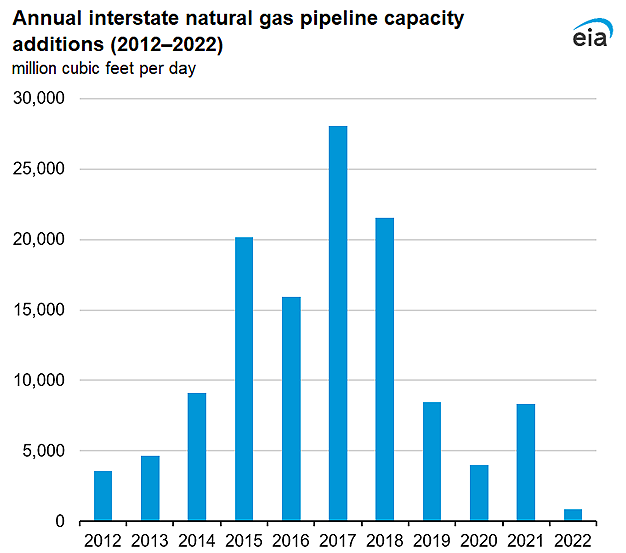
Data source: U.S. Energy Information Administration, State-to-State Capacity Tracker
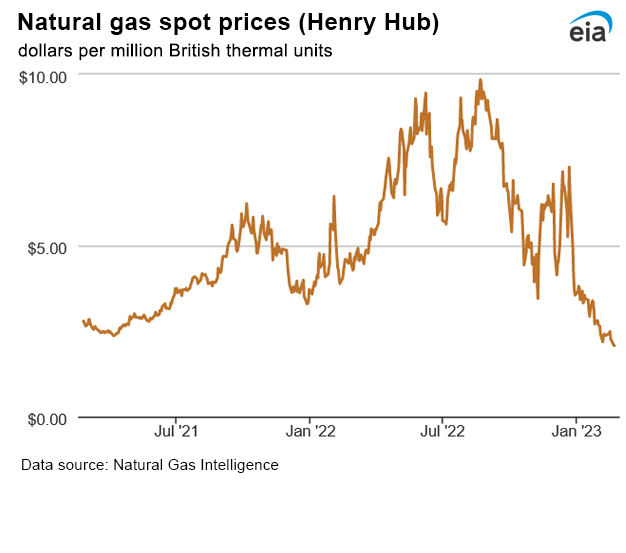
| Spot Prices ($/MMBtu) | Thu, 16-Feb |
Fri, 17-Feb |
Mon, 20-Feb |
Tue, 21-Feb |
Wed, 22-Feb |
|---|---|---|---|---|---|
| Henry Hub | 2.49 | 2.26 | Holiday | 2.10 | 2.08 |
| New York | 2.27 | 2.04 | Holiday | 1.86 | 1.98 |
| Chicago | 2.42 | 2.15 | Holiday | 2.14 | 2.20 |
| Cal. Comp. Avg.* | 6.70 | 5.68 | Holiday | 6.89 | 7.96 |
| Futures ($/MMBtu) | |||||
| March Contract | 2.389 | 2.275 | Holiday | 2.073 | 2.174 |
| April Contract | 2.485 | 2.352 | Holiday | 2.177 | 2.298 |
| *Avg. of NGI's reported prices for: Malin, PG&E Citygate, and Southern California Border Avg. | |||||
| Source: NGI's Daily Gas Price Index | |||||
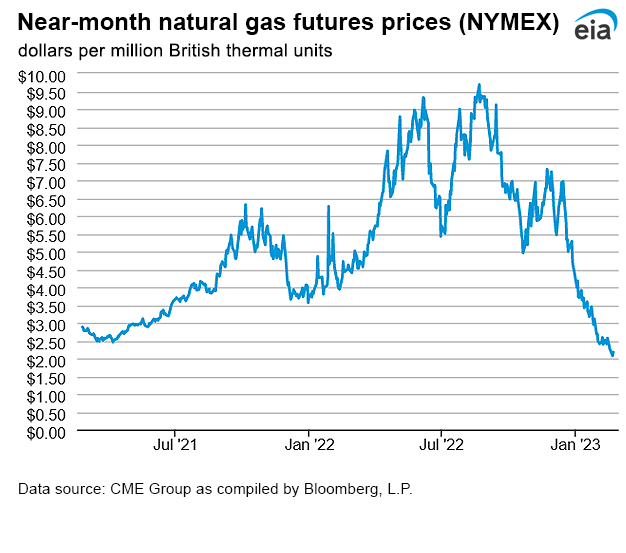
| U.S. natural gas supply - Gas Week: (2/16/23 - 2/22/23) | |||
|---|---|---|---|
Average daily values (billion cubic feet) |
|||
this week |
last week |
last year |
|
| Marketed production | 112.7 |
113.0 |
107.5 |
| Dry production | 100.5 |
100.6 |
95.1 |
| Net Canada imports | 4.6 |
4.2 |
5.9 |
| LNG pipeline deliveries | 0.1 |
0.1 |
0.2 |
| Total supply | 105.2 |
105.0 |
101.2 |
|
Data source: S&P Global Commodity Insights | |||
| U.S. natural gas consumption - Gas Week: (2/16/23 - 2/22/23) | |||
|---|---|---|---|
Average daily values (billion cubic feet) |
|||
this week |
last week |
last year |
|
| U.S. consumption | 88.3 |
86.4 |
92.1 |
| Power | 29.9 |
29.4 |
26.6 |
| Industrial | 24.1 |
24.0 |
25.0 |
| Residential/commercial | 34.4 |
32.9 |
40.4 |
| Mexico exports | 5.8 |
5.2 |
5.5 |
| Pipeline fuel use/losses | 7.3 |
7.3 |
7.2 |
| LNG pipeline receipts | 13.1 |
12.9 |
12.6 |
| Total demand | 114.5 |
111.8 |
117.3 |
|
Data source: S&P Global Commodity Insights | |||
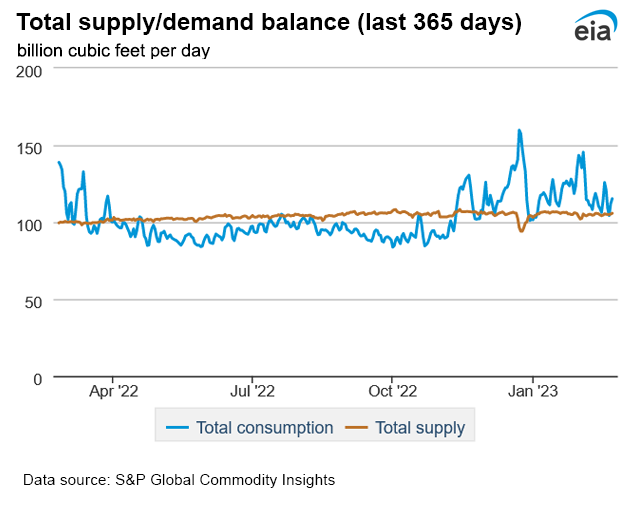
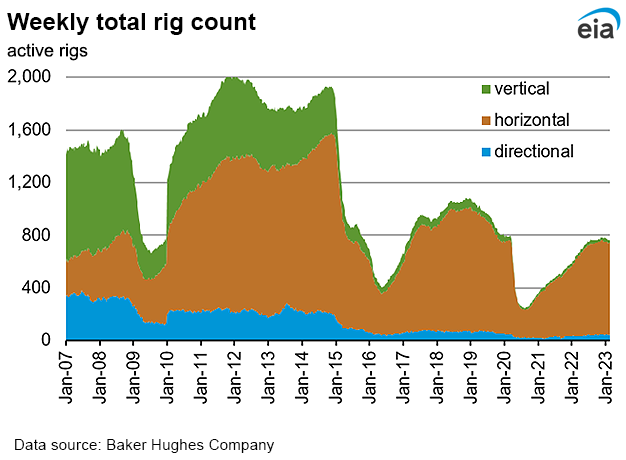
| Rigs | |||
|---|---|---|---|
Tue, February 14, 2023 |
Change from |
||
last week |
last year |
||
| Oil rigs | 607 |
-0.3% |
16.7% |
| Natural gas rigs | 151 |
0.7% |
21.8% |
| Note: Excludes any miscellaneous rigs | |||
| Rig numbers by type | |||
|---|---|---|---|
Tue, February 14, 2023 |
Change from |
||
last week |
last year |
||
| Vertical | 18 |
0.0% |
-28.0% |
| Horizontal | 700 |
0.0% |
18.8% |
| Directional | 42 |
-2.3% |
35.5% |
| Data source: Baker Hughes Company | |||
| Working gas in underground storage | ||||
|---|---|---|---|---|
Stocks billion cubic feet (Bcf) |
||||
| Region | 2023-02-17 |
2023-02-10 |
change |
|
| East | 479 |
498 |
-19 |
|
| Midwest | 575 |
601 |
-26 |
|
| Mountain | 106 |
114 |
-8 |
|
| Pacific | 108 |
122 |
-14 |
|
| South Central | 926 |
931 |
-5 |
|
| Total | 2,195 |
2,266 |
-71 |
|
| Data source: U.S. Energy Information Administration Form EIA-912, Weekly Underground Natural Gas Storage Report | ||||
| Working gas in underground storage | |||||
|---|---|---|---|---|---|
Historical comparisons |
|||||
Year ago (2/17/22) |
5-year average (2018-2022) |
||||
| Region | Stocks (Bcf) |
% change |
Stocks (Bcf) |
% change |
|
| East | 402 |
19.2 |
427 |
12.2 |
|
| Midwest | 457 |
25.8 |
490 |
17.3 |
|
| Mountain | 106 |
0.0 |
108 |
-1.9 |
|
| Pacific | 176 |
-38.6 |
187 |
-42.2 |
|
| South Central | 660 |
40.3 |
693 |
33.6 |
|
| Total | 1,800 |
21.9 |
1,906 |
15.2 |
|
| Data source: U.S. Energy Information Administration Form EIA-912, Weekly Underground Natural Gas Storage Report | |||||
| Temperature – heating & cooling degree days (week ending Feb 16) | ||||||||
|---|---|---|---|---|---|---|---|---|
HDDs |
CDDs |
|||||||
| Region | Current total |
Deviation from normal |
Deviation from last year |
Current total |
Deviation from normal |
Deviation from last year |
||
| New England | 171 |
-91 |
-71 |
0 |
0 |
0 |
||
| Middle Atlantic | 154 |
-95 |
-83 |
0 |
0 |
0 |
||
| E N Central | 190 |
-80 |
-77 |
0 |
0 |
0 |
||
| W N Central | 236 |
-38 |
-37 |
0 |
0 |
0 |
||
| South Atlantic | 102 |
-60 |
-48 |
8 |
1 |
4 |
||
| E S Central | 107 |
-55 |
-42 |
1 |
1 |
1 |
||
| W S Central | 103 |
-8 |
8 |
3 |
-1 |
1 |
||
| Mountain | 237 |
33 |
61 |
0 |
-1 |
0 |
||
| Pacific | 137 |
34 |
74 |
0 |
0 |
0 |
||
| United States | 161 |
-41 |
-25 |
2 |
1 |
1 |
||
|
Data source: National Oceanic and Atmospheric Administration Note: HDDs=heating degree days; CDDs=cooling degree days | ||||||||
Average temperature (°F)
7-day mean ending Feb 16, 2023
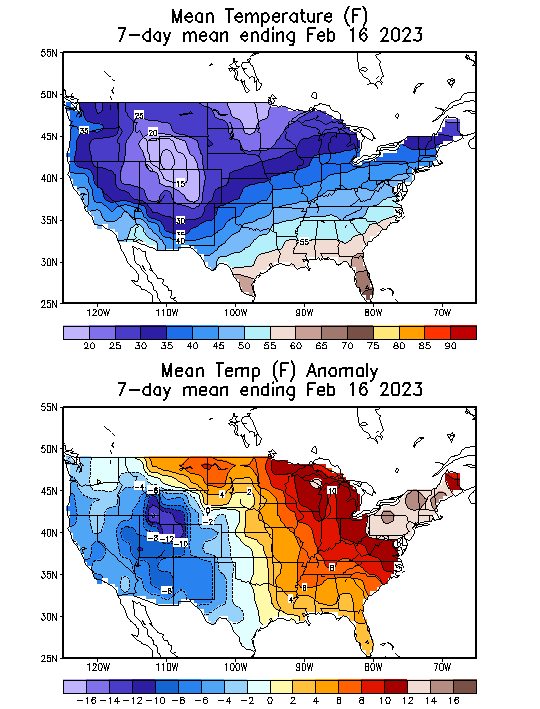
Data source: National Oceanic and Atmospheric Administration
Deviation between average and normal temperature (°F)
7-day mean ending Feb 16, 2023

Data source: National Oceanic and Atmospheric Administration

